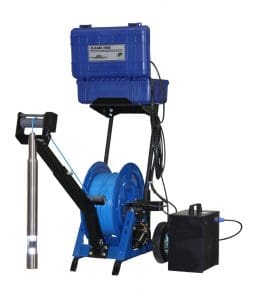It is hard to overestimate the value of video logging when it comes to diagnosing problems with a water supply well. While various diagnostic tools and chemical tests are available, there really is no substitute for being able to actually see what is going on in the well rather than trying to guess by the more indirect means. Well video logging, therefore, is the first step to determine issues with the well and develop an effective plan for rehabilitation or repair.
 To get the most information out of a well video survey, developing a proper plan for the survey is crucial. We review way too many video logs where it seems like the logger is just trying to complete the survey in the shortest amount of time possible and important information is missed, as a result. In preparation of developing the video survey plan, the well completion report should be reviewed along with any prior video surveys to identify any potential problem areas that will bear closer inspection during the survey. Any problems that are being experienced with the well, such as high iron content, sanding, etc., should be noted and accounted for in the video survey plan. Any prior repairs should be noted and incorporated in the plan for inspection. The speed at which the camera is moved down hole should also be designated ahead of time, with slower speeds and stops in more potentially problematic areas of the well. The clearest logging will take place as the camera is lowered down the well as often the return trip back out the well will be cloudy due the camera stirring up sediment in the well. It is important to plan to get most of the information you need to assess the well condition on the trip down the well and not count on clear video on the way back up.
To get the most information out of a well video survey, developing a proper plan for the survey is crucial. We review way too many video logs where it seems like the logger is just trying to complete the survey in the shortest amount of time possible and important information is missed, as a result. In preparation of developing the video survey plan, the well completion report should be reviewed along with any prior video surveys to identify any potential problem areas that will bear closer inspection during the survey. Any problems that are being experienced with the well, such as high iron content, sanding, etc., should be noted and accounted for in the video survey plan. Any prior repairs should be noted and incorporated in the plan for inspection. The speed at which the camera is moved down hole should also be designated ahead of time, with slower speeds and stops in more potentially problematic areas of the well. The clearest logging will take place as the camera is lowered down the well as often the return trip back out the well will be cloudy due the camera stirring up sediment in the well. It is important to plan to get most of the information you need to assess the well condition on the trip down the well and not count on clear video on the way back up.
Preparation for video logging should include allowing the well to sit idle for long enough for the water to clear and any particulates to settle. Often, running clean water into the well for a day or two prior the survey can substantially affect the clarity of the well water and therefore the video.
Most full-size cameras have the ability to view laterally as well as just downhole. Time should be taken with the lateral viewing capabilities to inspect welded joints, especially below the water surface, as this is one of the common points of failure in a well. Screen sections should be inspected thoroughly to determine if there is any damage or plugging and determine the degree and type of plugging.
Although it requires more planning and more expense, video logging under dynamic (pumping) conditions can provide valuable diagnostic information on what is going on in the well under pumping conditions. This can often be very different than what you see under static conditions in situations where sanding might be an issue, as an example. Small diameter video cameras are ideal for this type of application, but there may be some compromises with field of view and lighting in larger diameter wells.
While many problems that are detected during the video survey may be obvious, it is important to have the video reviewed by someone with experience in assessing well videos. Many unusual conditions can and do occur and it is important to correctly diagnose the problems. Failure to properly diagnose the problems can result in prescribing the wrong well rehabilitation techniques or repairs, leading to unnecessary expenditures that do little or nothing to fix the actual problems.

